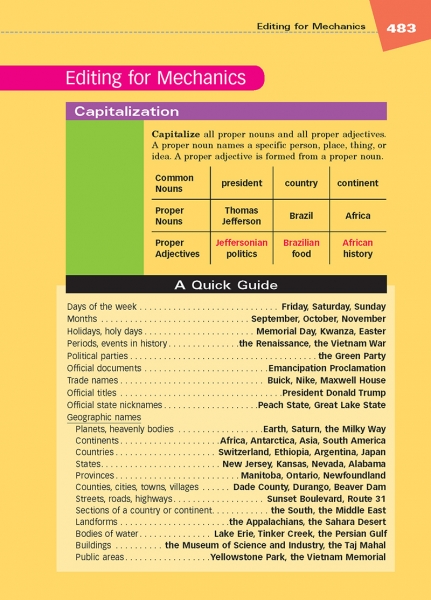Page 483 from

Start-Up Activity
Ask students to guess at the meaning of the following words:
-
majuscule
-
minuscule
Students who know that minuscule means "small" might be able to guess that majuscule means "large." If you tell them the root uncial means "by the inch," students might realize that both of these terms relate to large and small type. Before the third century C.E., Latin was written in majuscule letters (all capitals), which required multiple strokes to complete. However, to ease the work of scribes, minuscule letters (lowercase) were created, allowing one continuous cursive stroke to form a single letter. Eventually, capitals were used at the beginning of sentences and to emphasize proper nouns, and lowercase letters were used for most other words.
Of course, these are the basic rules we still use. The following pages explain a few particulars and exceptions.
Think About It
“I'm never going to be famous. My name will never be writ large on the roster of Those Who Do Things. I don't do anything. Not one single thing. I used to bite my nails, but I don't even do that anymore.”
—Dorothy Parker

Start-Up Activity
Ask students to guess at the meaning of the following words:
-
majuscule
-
minuscule
Students who know that minuscule means "small" might be able to guess that majuscule means "large." If you tell them the root uncial means "by the inch," students might realize that both of these terms relate to large and small type. Before the third century C.E., Latin was written in majuscule letters (all capitals), which required multiple strokes to complete. However, to ease the work of scribes, minuscule letters (lowercase) were created, allowing one continuous cursive stroke to form a single letter. Eventually, capitals were used at the beginning of sentences and to emphasize proper nouns, and lowercase letters were used for most other words.
Of course, these are the basic rules we still use. The following pages explain a few particulars and exceptions.
Think About It
“I'm never going to be famous. My name will never be writ large on the roster of Those Who Do Things. I don't do anything. Not one single thing. I used to bite my nails, but I don't even do that anymore.”
—Dorothy Parker


